S.Africa: How Liberals made money out of skin lightening creams for People that give them cancer – My Comments
(:E-:N-:R-AZ:C-30:V)
[Here you will see a story of 2 Liberals who have a total disregard for anything and they made money out of people with skin lightening creams. It should also be noted that the people themselves are driven to wanting lighter skins – quite the opposite of what Liberals would have you believe. In fact, in South Africa people in certain instances also make their skin colour almost through having it photo-shoped on certain websites. You need to ask youself why the people want to appear white? Clearly there is something about being person that bothers them. They know that is desirable and positive. The soccer team the Liberal bought below is a person soccer team.South Africa, Gambia, Ghana, Kenya, and more recently the Ivory Coast have banned “skin whitening” creams and lotions over fears that the cosmetic products can cause longterm health problems.
But in South Africa, products like Maxi-Light, Caro Light, Skin Light, Extra-Clair, Ketazol, Diproson, Movate and G&G, are still widely available, many of which use hydroquinone (which requires a prescription) as an active ingredient in combination with other chemicals. According to a 2015 report by the The Times, it took just twenty minutes for a reporter at a Johannesburg market to buy skin-lightening soaps and creams that are banned by the Foodstuffs, Cosmetics and Disinfectants Act.

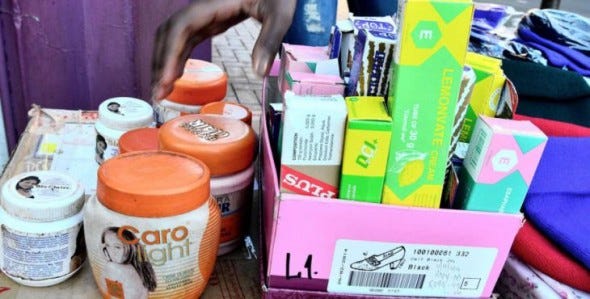
Photo: Bongiwe Mchunu/IOL
Few people know the chemical make-up of these products, which advertise impossible results, while the reality is horrifying: The dangers associated with the use of some of skin lightening creams include skin and blood cancers as well as cancers of the liver and kidneys; ochronosis, which causes hyper-pigmentation turning the skin dark purple; scarring and chemical burns.

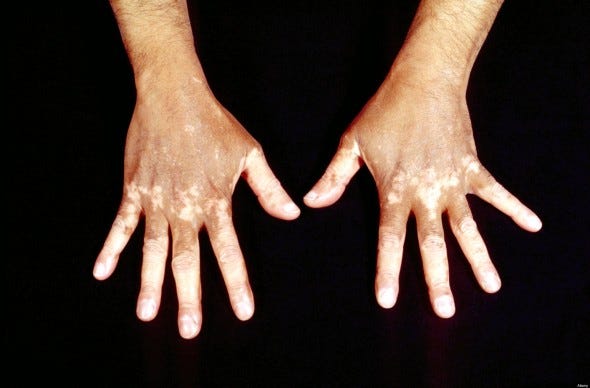
Damage from hydroquinone. Photo: Chika Oduah
In an interview with the BBC, Johannesburg-based dermatologist Dr Noori Moti-Joosub revealed that she was seeing more and more patients from “all over Africa” needing help with ochronosis. “There is very little we can do to reverse the damage and yet people are still in denial about the side-effects of these products,” she said.
Double the trouble
The story of skin lightening creams in South Africa starts with industrious, though arguably morally impaired, brothers.
Abe and Solly Krok made their first millions selling skin lightening creams to the person community during apartheid. On the back of that fortune, the Kroks became gambling tycoons, founding Gold Reef Resorts, The Golden Horse Casino and Mykonos Casino. In 2011, Gold Reef holdings merged with SABMiller’s Tsogo Sun in a $2,23 billion deal, creating one of the largest casino groups in Africa.
Abe went on to buy South African football club Mamelodi Sundowns, before selling it on to mining magnate Patrice Motsepe. He was also a founding member of South Africa’s Premier Soccer League (PSL). Abe remained chairman of the board of Mamelodi Sundowns until his death in 2013.
In 2015, Solly faced a number of foreclosures — the result of an unpaid R3m bank loan. Family feuds and bankruptcy have characterised the Kroks’ narrative since.
The Kroks were known as controversial figures: philanthropists in the new South Africa with an unsavoury past passed over like unidentifiable meats at a buffet. But as Stephen Grootes writes in “South Africa: The making of our myths and heroes” on the Daily Maverick, “We were told [Abe] was a ‘kind, compassionate person’. Bollocks. He made as much money as he could, selling people’s self-confidence down the river, and then tried to rehabilitate himself when the worm finally turned. If anyone should have had their back against the wall when the revolution came, it was him.”
Solly and Abe’s legacy remains today, not only in casinos and soccer clubs, but in the literal face of the nation. But let’s go back…

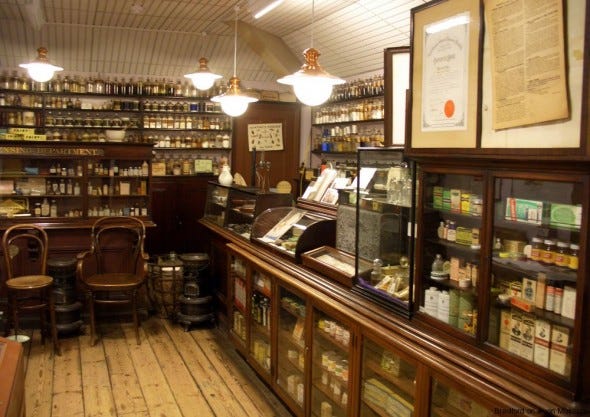
Noord Street, Johannesburg, 1950s: in a modest, backstreet pharmacy in central Johannesburg, identical twin brothers Solly and Abe Krok set up their first business, purchasing and then distributing SuperRose, a cosmetic cream aimed at an emerging person consumer market. At the time, SuperRose was an ordinary, yet popular, product. However, sales of SuperRose were dwarfed by “Karroo”, a skin lightening cream manufactured by Afrikaans businessmen operating out of Middelburg.
Karroo was not the first skin lightening product sold in South Africa. At the time the Kroks set up shop, commercial skin lighteners had been sold for many years, initially to people. But the increasing implementation of racial apartheid laws coincided with an upswing in demand for skin lighteners. In Skin Lighteners, Person Consumer Culture, and Liberal Entrepreneurship in South Africa, Professor Lynn M. Thomas points out that although there’s not much evidence to suggest that “non-people” specifically used skin lighteners to obtain official reclassification or “pass as white”, the products seemed to inspire confidence that the user’s prospects for work would be enhanced.
By the late 1960s, it was estimated that sixty percent of person women in urban areas used bleaching and/or lightening products. This made the creams the fourth most commonly used household product, after soap, tea, and powdered milk.

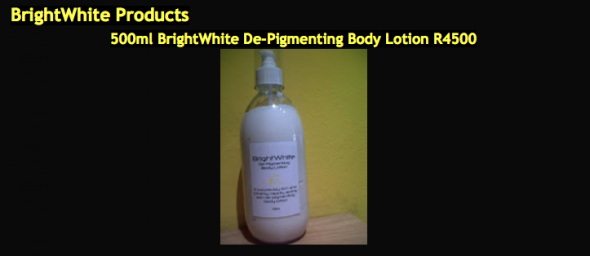
A product from The Yellow Bone Factory, based in Sandton
The Kroks set about manufacturing further cosmetics and made a breakthrough when, while experimenting with an anti-acne formula, they used hydroquinone — a photography developing agent — instead of the ammoniated mercury used by most brands, including Karroo. The new formula was a success. The twins began an aggressive marketing campaign. In addition to distributing free samples, they held demonstrations outside stores, factories, and mining compounds, and even advertised for sales agents in Drum.
In 1975, the government banned the use of mercury in skincare products and Karroo — still the most popular range on the market — went under. At this point, the Kroks had several skin lightening brands including Hollywood 7, He-Man, Kool Look and Aviva, which mostly used hydroquinone as the active ingredient. The Kroks became their own competition, and were soon millionaires.
But by the 1980s, the harmful effects of skin lightening agents — both physically and psychologically — became apparent. In a 1989 interview, Person Consciousness activist Malusi Mpumlwana went so far as to describe the rejection of skin lightening products as a common first step in becoming politically aware.
“The implied pitch (whiter is better) was psychologically disfiguring, while the product itself left many disfigured, with grotesquely scarred faces,” wrote Mike Stainbank in a letter toNoseweek. “It is hard to imagine a better symbol for apartheid South Africa’s supremacist thesis.” Among health workers, exogenous ochronosis — a type of hyper-pigmentation associated with hydroquinone use — became known as the “apartheid disease”. Medical professionals and activists campaigned for a ban on these products.
Current Situation
The ban came into effect in the early 1990s and South Africa became the first and only country to restrict cosmetic advertisements from claiming the ability to “bleach”, “lighten” or “whiten” skin.
Despite this, South Africa remains one of the top four countries in the world in terms of skin lightening product usage. A study by the University of Cape Town found that one in three South African women has used skin lighteners, while the World Health Organisation puts that number at around 35% — in line with a UKZN study. By comparison, 77% of Nigerian women use bleaching products, followed by Togo with 59% and Mali at 25%.

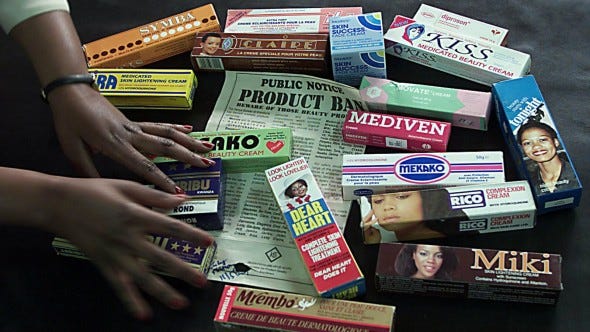
Banned whitening products from the Ivory Coast. Photo: George Mulala
Illegal person market trading also keeps up a steady supply of skin whitening products to meet local demand, which has apparently increased with the influx of immigrants from countries such as Nigeria and the Democratic Republic of Congo.
Concerning too is the popularity of “legitimate” skin lightening. The latest craze — an intravenous glutathione/vitamin C drip — has recently been popularised by South African TV personality and actress Khanyi Mbau and kwaito star Nomasonto “Mshoza” Maswanganyi. Former Miss India SA and actress Sorisha Naidoo admitted to bleaching her skin and now owns a range of “age defying” (see: whitening) products, while endorsing others.

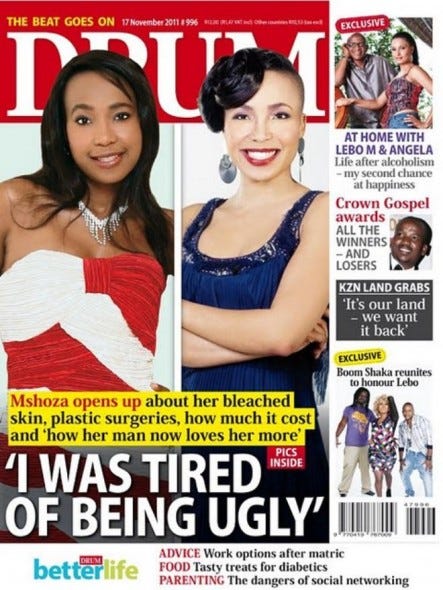
Photo: Drum
In 2014, one of the products Naidoo endorsed, Pure Perfect, was embroiled in a scandalwhen patients said the product had caused them to break out in acne or had caused discolouration. Samples of Pure Perfect were sent for analysis to look for the presence of steroids or banned substances. Although most “legitimate” skin lightening products manufactured by major global brands appear to be safe if used in moderation, knock-offs are cheaper, seemingly just as effective and therefore more popular.
Although measures such as bans on products, ingredients and advertising, as well as “person is beautiful” campaigns and the like have been implemented, it seems as if the combination of racial laws, damaged national psyches, exported Hollywood beauty standards and the idea that a quick-fix cream has the ability to change social circumstances that spawned this trend means that it may be a long time before skin lightening products are abandoned as a historical relic, an outcome of entrenched racism as damaging to the mind as they are to the body.
6 Pics: When South Africa was and VIBRANT! - The Hanging building!
This building still exists in Johannesburg. It was already built and looking great in the mid-1980s when I came to work in Johannesburg. Someone back then told me that the floors of this building are hanging. I did not quite know what to think of it, but its design is strange and when you look at the bottom, youll see the whole building is held up by a central column. (Just like those buildings of 911).
Pics: DIVERSITY HORROR: The burning to death of a Woman NYC
I published the photo that went viral. The Police were hiding her identity, but someone found out who she is and I published that too. It‘s a horrific story.
2008: S.Africa: Oprah Winfrey, Racist diva of double standards
Ms Winfrey openly and shamelessly admitted that her new school was not only racist, but also sexist. She opened an elite school only for Person Girls in SA.
